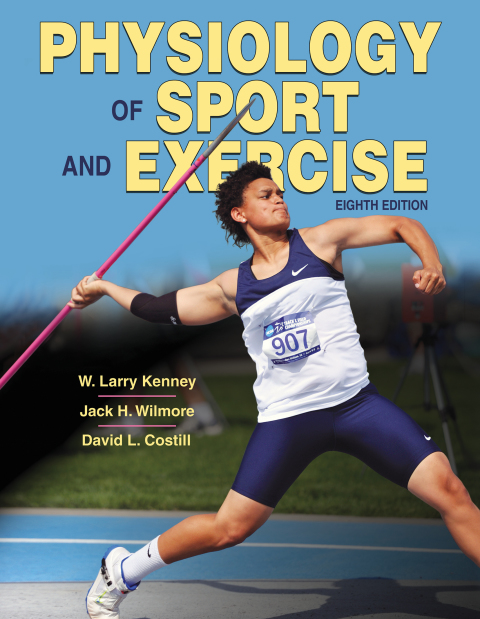Description
Efnisyfirlit
- Title Page
- Copyright
- Contents
- Research Perspectives Finder
- Preface
- Student and Instructor Resources
- Acknowledgments
- Photo Credits
- Introduction: An Introduction to Exercise and Sport Physiology
- Focus of Exercise and Sport Physiology
- Acute and Chronic Responses to Exercise
- The Evolution of Exercise Physiology
- Exercise Physiology in the 21st Century
- Research: Turning Curiosity Into Science
- Part I: Exercising Muscle
- Chapter 1. Structure and Function of Exercising Muscle
- Anatomy of Skeletal Muscle
- Muscle Fiber Contraction
- Muscle Fiber Types
- Skeletal Muscle and Exercise
- Chapter 2. Fuel for Exercise: Bioenergetics and Muscle Metabolism
- Energy Substrates
- Controlling the Rate of Energy Production
- Storing Energy: High-Energy Phosphates
- The Basic Energy Systems
- Interaction of the Energy Systems
- The Crossover Concept
- The Oxidative Capacity of Muscle
- Chapter 3. Neural Control of Exercising Muscle
- Structure and Function of the Nervous System
- Central Nervous System
- Peripheral Nervous System
- Sensory-Motor Integration
- Chapter 4. Hormonal Control During Exercise
- The Endocrine System
- Endocrine Glands and Their Hormones: An Overview
- Hormonal Regulation of Metabolism During Exercise
- Hormonal Regulation of Fluid and Electrolytes During Exercise
- Hormonal Regulation of Caloric Intake
- Part II: Muscle Energy
- Chapter 5. Energy Expenditure
- Measuring Energy Expenditure
- Estimating Energy Expenditure
- Predicting Energy Expenditure
- Energy Expenditure at Rest and During Exercise
- Chapter 6. Fatigue, Muscle Soreness, and Muscle Cramps
- Fatigue and Its Causes
- Critical Power: The Link Between Energy Expenditure and Fatigue
- Muscle Soreness
- Exercise-Induced Muscle Cramps
- Part III: Cardiovascular and Respiratory Function
- Chapter 7. The Cardiovascular System and Its Control
- The Heart
- Vascular System
- Blood
- Chapter 8. The Respiratory System and Its Regulation
- Pulmonary Ventilation
- Pulmonary Volumes
- Pulmonary Diffusion
- Transport of Oxygen and Carbon Dioxide in the Blood
- Gas Exchange at the Muscles
- Regulation of Pulmonary Ventilation
- Afferent Feedback From Exercising Limbs
- Exercise Training and Respiratory Function
- Chapter 9. Cardiorespiratory Responses to Acute Exercise
- Cardiovascular Responses to Acute Exercise
- Respiratory Responses to Acute Exercise
- Recovery From Acute Exercise
- Part IV: Exercise Training
- Chapter 10. Principles of Exercise Training
- Terminology
- General Principles of Training
- Resistance Training Programs
- Anaerobic and Aerobic Power Training Programs
- Chapter 11. Adaptations to Resistance Training
- Resistance Training and Gains in Muscular Fitness
- Mechanisms of Gains in Muscle Strength
- Interaction Between Resistance Training and Diet
- Resistance Training for Special Populations
- Chapter 12. Adaptations to Aerobic and Anaerobic Training
- Adaptations to Aerobic Training
- Adaptations to Anaerobic Training
- Adaptations to High-Intensity Interval Training
- Specificity of Training and Cross-Training
- Chapter 13. Prescription of Exercise for Health and Fitness
- Health Benefits of Regular Physical Activity and Exercise
- Exercise and Cognitive Function
- Physical Activity Recommendations
- Health Screening
- Exercise Prescription
- Monitoring Exercise Intensity
- Exercise Programming
- Exercise and Rehabilitation of People with Diseases
- Part V: Environmental Influences on Performance
- Chapter 14. Exercise in Hot and Cold Environments
- Body Temperature Regulation
- Physiological Responses to Exercise in the Heat
- Health Risks During Exercise in the Heat
- Acclimation to Exercise in the Heat
- Exercise in the Cold
- Physiological Responses to Exercise in the Cold
- Health Risks During Exercise in the Cold
- Chapter 15. Altitude, Hyperbaric Environments, and Microgravity
- Environmental Conditions at Altitude
- Physiological Responses to Acute Altitude Exposure
- Exercise and Sport Performance at Altitude
- Acclimation: Chronic Exposure to Altitude
- Altitude: Optimizing Training and Performance
- Health Risks of Acute Exposure to Altitude
- Hyperbaric Environments
- Microgravity
- Part VI: Optimizing Performance in Sport
- Chapter 16. Training for Sport
- Optimizing Training
- Periodization of Training
- Overtraining
- Tapering for Peak Performance
- Detraining
- Chapter 17. Nutrition, Body Composition, and Obesity
- Classification of Nutrients
- Water and Electrolyte Balance
- Nutrition and Athletic Performance
- Assessing Body Composition
- Body Composition, Weight, and Sport Performance
- Obesity
- Weight Loss Management Guidelines
- Role of Physical Activity in Weight Management and Risk Reduction
- Chapter 18. Ergogenic Aids in Sport
- Researching Ergogenic Aids
- Ergogenic Aids with Established Evidence of Efficacy
- Ergogenic Aids with Emerging Evidence of Efficacy
- Prohibited Substances and Techniques
- Part VII: Special Considerations in Sport, Exercise, and Physical Activity
- Chapter 19. Children and Adolescents in Sport and Exercise
- Growth, Development, and Maturation
- Physiological Responses to Acute Exercise
- Physiological Adaptations to Exercise Training
- Physical Activity Patterns Among Youth
- Sport Performance and Specialization
- Special Issues
- Chapter 20. Aging in Sport and Exercise
- Height, Weight, and Body Composition
- Physiological Responses to Acute Exercise
- Physiological Adaptations to Exercise Training
- Sport Performance
- Special Issues
- Chapter 21. Sex Differences in Sport and Exercise
- Sex Versus Gender in Exercise Physiology
- Body Size and Composition
- Physiological Responses to Acute Exercise
- Physiological Adaptations to Exercise Training
- Sport Performance
- Special Issues
- Chapter 22. Cardiovascular Disease and Physical Activity
- Prevalence of Cardiovascular Disease
- Forms of Cardiovascular Disease
- Understanding the Disease Process
- Cardiovascular Disease Risk
- Reducing Risk Through Physical Activity
- Risk of Heart Attack and Death During Exercise
- Exercise Training and Rehabilitation of Patients with Heart Disease
- Glossary
- References
- Index
- About the Authors






Reviews
There are no reviews yet.